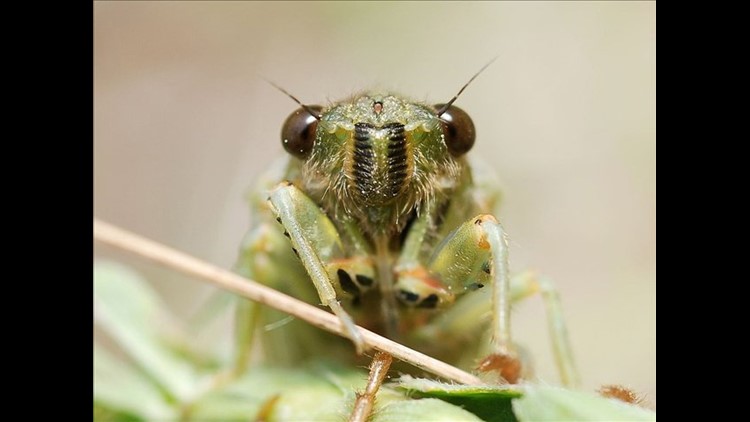(CNN) — They emerge from the ground after 17 years, their worm-like bodies creating hundreds of peanut-sized holes near the base of your tree. As they begin to climb, their dark brown skin starts to shed. Two beady red eyes appear.
By the time they reach a steady branch their transparent wings have stretched, opened and closed. Within an hour their white bodies will turn black.
Soon the males will start to sing.
The life cycle of the periodical cicada is the stuff of horror movies: millions of large flying insects that crawl out of the ground after 17 years to mate loudly, lay eggs and die.
There are 12 broods, or groups, of the 17-year cicadas, says Dan Mozgai, operator of CicadaMania.com. There are also three 13-year broods. Every year between April and June one or two cicada broods emerge in a different region of the United States.
After they emerge, the adult cicadas mate and the females dig holes in tree branches to lay their eggs. The eggs hatch six to eight weeks later and the tiny cicadas fall to the ground, where they’ll burrow into the ground to feed off the tree root’s sap for the next 13 to 17 years.
This year Brood II is beginning to appear in Connecticut, Maryland, North Carolina, New Jersey, New York, Pennsylvania and Virginia. You can see reported sightings of the insect on this map. Next year Broods III will arrive in Iowa, Illinois and Missouri, and Brood XXII will come to Louisiana and Mississippi.
While the insects don’t bite and aren’t poisonous, the females may mistake you for a singing male if you’re mowing the lawn or using power tools, Mozgai says; the vibrations of such machines are similar to the cicadas’ mating song.
It’s a song that’s sung loud and obnoxiously through the day. So much so that Mozgai has a wedding planner section on his website for brides who want to avoid a cicada-march down the aisle. (In 1902, a speech by President Teddy Roosevelt was reportedly drowned out by cicadas – not an easy feat against a man who used to call cattle for a living.)
But Mozgai’s favorite thing about cicadas is seeing people’s reactions to them each year, he says. Some write YouTube songs. Others do parodies. A few make recipes (apparently if you collect the soft white cicadas as they emerge from the ground, you can blanche them and freeze for future use).
Gene Kritsky isn’t a big fan of cicada-flavored food, but he does love pretty much everything else about them. He has been studying the insect since the early 1970s when he was an undergrad at Indiana University. In 2004 he published “Periodical Cicadas: The Plague and the Puzzle,” named partially for the Pilgrims, who thought cicadas were eerily similar to the locust plague.
“They really are bugs of history,” says Kritsky, who is chair of the biology department at the College of Mount St. Joseph in Cincinnati.
Scientists have been studying the evolution of the cicada broods for generations. There are more than 8,000 historical records of their emergences, Kritsky says, going back to the 1600s. Biologists believe they hide underground for 13- or 17-year periods to keep predators from adapting to their life cycle.
Evidence of this comes from the annual cicada, which has a specific predator: the cicada killer wasp. Periodical cicadas do not have a similar foe. The prime number hibernation period seems to be the reason, Kritsky says.
“They could very easily pattern to evolve an eight-year cycle,” he says of potential predators. “They could do four and four. But there’s no way to get to 17 gradually. It’s either 1 or 17.”
Since the mid-1990s, Kritsky and his colleagues have seen broods emerging about four years early, something they believe is related to global warming. (Warming soil temperatures signal to the grown cicadas each spring that it’s time to emerge.)
In 2000, Brood X emerged early. “In 2017, if they emerge in that area again, we will have witnessed a whole new evolution of a brood of cicadas,” Kritsky says excitedly.
As for people in the Northeast dealing with the invasion of Brood II this year, Kritsky has some simple advice: “Enjoy them.” And if you see them in your backyard, report it to his website at www.msj.edu/cicada.



